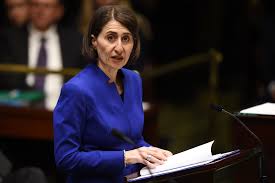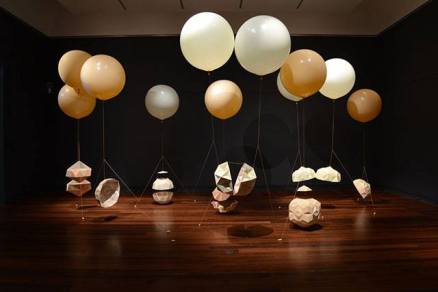 On Monday, the NSW Premier Gladys Berejiklian, below, abandoned all pretence at community consultation in government planning decisions. Hours before the second community consultation about the future of the Powerhouse Museum, Ultimo, was due to begin, she announced that a new facility would be built on the old DJ’s carpark site on Parramatta River, above, to be purchased from Parramatta Council at a cost of $140 million. “Any future redevelopment at Ultimo would potentially include residential units, while retaining an arts and cultural presence,” she said. The interests and values of the Rum Rebellion had won again.
On Monday, the NSW Premier Gladys Berejiklian, below, abandoned all pretence at community consultation in government planning decisions. Hours before the second community consultation about the future of the Powerhouse Museum, Ultimo, was due to begin, she announced that a new facility would be built on the old DJ’s carpark site on Parramatta River, above, to be purchased from Parramatta Council at a cost of $140 million. “Any future redevelopment at Ultimo would potentially include residential units, while retaining an arts and cultural presence,” she said. The interests and values of the Rum Rebellion had won again.
 This was no longer the pretence at community consultation, conducted by the same people, over the future of the North Parramatta Heritage Precinct four years ago, when participants were encouraged to think widely and creatively. By the second session the results had been distilled into one option of choosing where to place potential buildings.
This was no longer the pretence at community consultation, conducted by the same people, over the future of the North Parramatta Heritage Precinct four years ago, when participants were encouraged to think widely and creatively. By the second session the results had been distilled into one option of choosing where to place potential buildings.
As it was, my heart sank as we read the two key questions in the first consultation. This was the Museum of Arts and Sciences (MAAS) Project Public Meeting (Parramatta), organised by the Department of Planning and Environment with MAAS, on Wednesday evening, July 26. About 100 people grouped around tables had one and a half hours to respond –
Question 1: What would you like to see, do and experience at the new Museum in Western Sydney? What would make it an exciting place for you and your family/friends to visit?
Question 2: If some Powerhouse Museum presence stays at Ultimo, what would you like to see, do and experience?
 Once again the parameters of community involvement were strictly limited. There had been media reports that former Premier Mike Baird’s developer driven thought bubble of selling the Powerhouse Museum, (SMH photo right, by Louise Kennerley) and relocating it to Parramatta had not withstood financial scrutiny and community pressure was forcing a rethink. In booking for the free event, people were invited to submit three key questions they would like answered in the consultations.
Once again the parameters of community involvement were strictly limited. There had been media reports that former Premier Mike Baird’s developer driven thought bubble of selling the Powerhouse Museum, (SMH photo right, by Louise Kennerley) and relocating it to Parramatta had not withstood financial scrutiny and community pressure was forcing a rethink. In booking for the free event, people were invited to submit three key questions they would like answered in the consultations.
Mine were along the lines of questioning the assumptions on which the project was based:
- Why dismantle a popular and well established cultural institution in the heart of Sydney?
- Why move it to a small flood prone site on the bank of the Parramatta River?
- Why not consider a museum for Parramatta that relates to its rich indigenous past and early colonial history already holding national and World Heritage values, like the North Parramatta heritage precinct?
It wasn’t long before it was clear that many others were questioning the same assumptions and offering a range of alternative proposals.
Organisers stated ,”The new museum will be designed with community input and will be on the cutting edge of science and innovation. To deliver the best possible museum, a business case has been established to ensure all options are investigated, tested and analysed. Community consultation is an important element of the business case and local community members are invited to be part of the conversation.”
People certainly responded: Why, if you are going to spend $500 million delivering the museum to western Sydney, spend $100 million purchasing the Parramatta River site and another $100 million on flood proofing it, before you even begin building a new museum? You could do so much more with that money. Parramatta is difficult to access from many parts of western Sydney and now with new road tolls and poor public transport, it’s not going to get any easier. Why the rush? The government wants the business case for the project to be submitted to cabinet before the end of the year. For such a major institution, why not spend time engaging community and experts in conversation from the ground up?
Why not operate like the Smithsonian Institution which now has 19 museums and the National Zoo across the United States? “Congress authorised acceptance of the Smithson bequest on July 1, 1836, but it took another ten years of debate before the Smithsonian was founded. Once established, the Smithsonian became part of the process of developing an American national identity—an identity rooted in exploration, innovation, and a unique American style.”
In western Sydney, MAAS could operate like Western Sydney University with its network of campuses across the region. Indeed it could be linked to the university and work with the  existing arts centres serving different parts of the region. An excellent example of such a productive collaboration was last year’s Gravity (and Wonder) exhibition, left, at Penrith Regional Gallery. What about the new technology park planned for Luddenham and links to the Blue Mountains World Heritage Centre?
existing arts centres serving different parts of the region. An excellent example of such a productive collaboration was last year’s Gravity (and Wonder) exhibition, left, at Penrith Regional Gallery. What about the new technology park planned for Luddenham and links to the Blue Mountains World Heritage Centre?
On the “community” consultative process alone, there were plenty of questions: Where was the cultural diversity among the participants, which is such a feature of Parramatta, let alone the region’s population? Where were the young people for whom the future museum is so important?
The deadline for responses about the MAAS project is August 18. You can reply to the question: “Is there anything else that should be taken into consideration when developing the business case?” https://www.surveymonkey.com/r/536XXPF
Highlighting the state government wish for haste was the Parramatta City Council meeting on Monday, July 10, conducted by administrator Amanda Chadwick and attended by 200 people. Twenty speakers were registered for the public forum including Better Planning Network, National T rust of Australia, Australian Institute of Architects, Saving Sydney’s Trees, Parramatta Female Factory Friends, ParraGirls, Darug Elder Kerrie Kenton and North Parramatta Resident Action Group, left.
rust of Australia, Australian Institute of Architects, Saving Sydney’s Trees, Parramatta Female Factory Friends, ParraGirls, Darug Elder Kerrie Kenton and North Parramatta Resident Action Group, left.
 Present also was Sydney Morning Herald columnist, architectural critic and former Sydney city councillor Elizabeth Farrelly. She couldn’t suppress her chortles at the absurdity of the administrator’s role. Every time the administrator Amanda Chadwick said a motion was before council, followed by “I have resolved . . .”, her smiles broke out afresh. Her report the following Saturday was scathing –
Present also was Sydney Morning Herald columnist, architectural critic and former Sydney city councillor Elizabeth Farrelly. She couldn’t suppress her chortles at the absurdity of the administrator’s role. Every time the administrator Amanda Chadwick said a motion was before council, followed by “I have resolved . . .”, her smiles broke out afresh. Her report the following Saturday was scathing –
“Oh, and the item on everybody’s lips: the new development control plan enabling UrbanGrowth’s massive, 20-storey resi-velopment of the area euphemistically dubbed the Parramatta North Urban Transformation Precinct. Our finest treasures reduced to that. PNUTP. More than a thousand public objections. Twenty impassioned speakers. The screens scroll. RESOLVED CHADWICK.
“Why cram so much in? Why vet speakers? Why ram this through when national and perhaps world heritage listings are expected any week?
“Could it be because this was the last ordinary “meeting” before democracy returns in September? Is this how we do things now in Sydney? Is this “inclusion”? Approved voices only? Excuse me, Big Sister, but how exactly is this different from tyranny? From Big Brother’s deliberate erasure of history? How is “inclusive, resilient” (Parramatta promotional buzzwords) not classic doublethink?
“It’d be funny if it weren’t so dangerous, running hand-in-murderous-glove with the wholescale destruction of everything . . . ”
The only speaker in favour was the head of the UrbanGrowth team planning the North Parramatta transformation. She stated that people were stopping her in the street saying yes, yes, yes. That was undoubtedly happening at the archaeology open day, when the focus was on the history and heritage and not the proposed development to come.
 Conflict over the national heritage site continues to escalate. NPRAG president, Suzette Meade, left, wrote yesterday – “Thanks to our continued relationship with University of Sydney’s Professor Peter Phibbs from Sydney School of Architecture, Design and Planning we were able to secure two events to be included in the University’s Festival of Urbanism.
Conflict over the national heritage site continues to escalate. NPRAG president, Suzette Meade, left, wrote yesterday – “Thanks to our continued relationship with University of Sydney’s Professor Peter Phibbs from Sydney School of Architecture, Design and Planning we were able to secure two events to be included in the University’s Festival of Urbanism.
“Urban Growth tried very hard to dissuade the university from holding a tour on the site claiming it was a construction site and unsafe, and then followed that up with an offer to hold the tour themselves and provide free lunch for tour goers. The university stood their ground and secured Dr Terry Smith local historian and myself to provide a two hour tour of the Cumberland Hospital Precinct to architects, planners and industry specialists.
“We had also included a discussion on the future of the Heritage Precinct, this was passed on to the Western Sydney University to hold at the Female Orphanage/Whitlam Institute. Unfortunately we were told there was no room for NPRAG to speak and then advised Urban Growth NSW were invited to be keynote speaker. We continued to push the university hard for equal representation and negotiated to allow a ‘community member’ to speak at the event. Speaking will be long time advocate for the precinct and former NPRAG committee member Jason Burcher.”
 Better news from the Premier on Monday was the announcement of $100 million for the redevelopment of the Riverside Theatres. There is no doubt that this commitment is the result of years of negotiation between Parramatta Council and the state government, following the enormous success of the theatres under the direction of Robert Love.
Better news from the Premier on Monday was the announcement of $100 million for the redevelopment of the Riverside Theatres. There is no doubt that this commitment is the result of years of negotiation between Parramatta Council and the state government, following the enormous success of the theatres under the direction of Robert Love.


















